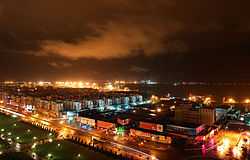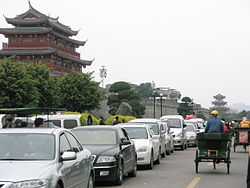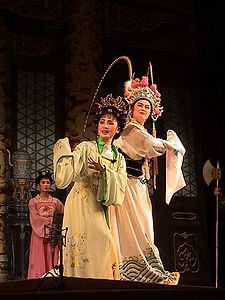Chaoshan
| Chaoshan
珠江三角洲 | |
|---|---|
 | |
| Country |
|
| Major Cities |
Shantou Jieyang Chaozhou |
| Government | |
| • Governor of Guangdong | Zhu Xiaodan |
| Area | |
| • Metro | 10,415 km2 (4,021 sq mi) |
| Population | |
| • Metro | 13,937,897 |
| Time zone | CST (UTC+8) |
Teochew or Cháoshàn (潮汕) refers to the linguistic and cultural region in the east of Guangdong, China, developing into a single metropolis. This region is the origin of the Min Nan dialect Teochew (潮汕話). The region is also known as Chiuchow in Cantonese. It consists of cities of Kieiang, Teochew and Swatow and Swabue. It linguistically differs from the rest of Guangdong province which consists of Leizhou Min, Cantonese, and Hakka speakers.[1] It is historically important as the homeland of many Thais, Singaporeans, and Malaysians of Chinese descent.
Origin and Metropolis
The name "Chaoshan" (潮汕) is a contraction of the names of two of its administrative areas, the prefecture-level cities of Chaozhou (潮州), and Shantou (汕头), which have agglomerated into a single extremely dense metropolitan area and among China's most densely populated. It is Guangdong's second largest metropolitan area after the Pearl River Delta, and part of the Southern China Coast Megalopolis.
Economy
The Chaoshan region is the second largest economy in Guangdong, after the Pearl River Delta, however, it is still considered quite small in scale, in comparison.[2] In recent years, due to corruption and car smuggling in the 1980s and 1990s, the central government has chosen to slow down growth of this region even though it is still designated as an SEZ (Special Economic Zone). As a result, business has slowed compared to other areas in Guangdong. In recent years Li Ka-shing has also invested heavily in the education and healthcare of this region, in response toe the potential for growth.
There have been proposals to the Chinese government to amalgamate the whole region into one whole Special Economic Zone,[3] as the split of the region into 3 different cities in 1991 has rapidly slowed down the level of economic growth in the region, with the per capita GDP of Shantou reaching only US$ 4,250, whereas it was US$ 8,600 in the whole province. Since the period of 2007-2012, there has only been a 10% growth in GDP, whereas the average economic growth in the whole province has been around 15% in a similar period of time.
Geography
Encompassing the cities of Chaozhou, Shantou, and Jieyang, the Chaoshan region, with a permanent population of 13,937,897 at the end of 2010, covers an area of 10,415 km2 (4,021 sq mi) that stretches from Jieyang on the coast to the border of Fujian.
| City | Romanization | Population (2010) | Image | Information | City Map |
|---|---|---|---|---|---|
| Shantou 汕头 |
Pinyin: Shàntóu Peng'im:Sua-thâu |
5,391,028 |  |
Shantou is the main city of the Chaoshan region. It is a port on the South China Sea, and is one of China's Special Economic Zones. |  |
| Jieyang 揭阳 |
Pinyin: Jiēyáng |
5,877,025 |  |
Jieyang is the most populous city of the region. It is one of the fastest growing cities in terms of population. |  |
| Chaozhou 潮州 |
Pinyin: Cháozhōu Peng'im:Diê-ziu |
2,669,844 |  |
Chaozhou is the smallest of the three cities in the Chaoshan region. It is an old town with a large historic and cultural value, which is now undergoing urbanisation. |  |
Culture and language
This is a unique area with its own culture that is quite different from its neighbours in Guangdong and the rest of China. It does, however, share similarities to the Minnan areas just north of Chaoshan in Fujian Province. One of the main reasons for its uniqueness is its language, called Chaozhou (also spelt Teochew). It is said that this dialect of Chinese is one of the most difficult ones to master, as it has 8 tones compared to the 4 tones found in Mandarin. Music, opera, and food are further characteristics that distinguish Chaoshan people from the rest of Guangdong.
Chaozhou Dialect (潮州話), by which the Chaozhou culture conveys, is considered one of the more conservative Chinese dialects, as it preserves features from ancient Chinese that have been lost in some of the other modern dialects of Chinese. It is spoken by about 10 million people in local Chaozhou and approximately 2-5 million overseas.

Chaozhou opera (潮劇) is a traditional art form which has a history of more than 500 years and is now loved by 20 million Chaozhou natives in over 20 countries and regions. Based on the local folk dances and ballads, Chaozhou opera has formed its own style under the influence of Nanxi opera. Nanxi is one of the oldest Chinese operas that originated in the Song Dynasty. Its tunes are graceful and pleasant, full of local color. The old form of choral accompaniment still remains its special features. Clowns and females are the most distinctive characters in a Chaozhou opera, and fan-playing and acrobatic skills are more prominent than in other types of performances.
Gongfu tea (工夫茶), the 'espresso' of Chinese teas with a formidable kick, which was first sipped back in the Song Dynasty, is still flourishing and remains an important part of social etiquette in Chaozhou. If you visit a family, you can be sure of at least one round of Ganghu tea. Though it tastes bitter when it first reaches your mouth, it is the lingering aftertaste that makes Ganghu tea probably the most charming tea culture in China. Drinking Ganghu tea is in fact a process of aesthetics rather than a solution to thirst.
At the local teahouse, tea service is often accompanied with Chaozhou music (潮州音樂). String music, the gong and drum music, the ancient music of set flutes are the traditional play forms of Chaozhou music. Chaozhou string music is made up of mostly plucked and bowed string instruments, and on some occasions, wind instruments are used. The most characteristic instruments are the rihin (二弦), tihu (提胡) and yahu (all two-stringed bowed lutes), the sanxian, pipa, ruan, guzheng, and yangqin. The number of instruments and performers in the ensemble is flexible and depends on the availability of instruments and musicians to play them - but to have an even and balanced texture only one of each instrument is preferred. Chaozhou drum music includes the big drum and gong, the small drum and gong, the dizi set drum and dong and su drum and gong ensembles. The current Chaozhou drum music is said to be similar to the form of the Drum and Wind Music of the Han and Tang Dynasties. Chaozhou guzheng (潮州古筝) is also regarded a major genre of Southern style of Chinese guzheng.
Related links
References
- ↑ James Stuart Olson (1998). An Ethnohistorical Dictionary of China. Greenwood Press. ISBN 0-313-28853-4.
- ↑ http://www.na-businesspress.com/JABE/TianWeb12-6.pdf
- ↑ http://www.chinadaily.com.cn/business/2013-03/14/content_16307866.htm
| Wikimedia Commons has media related to Chaoshan. |